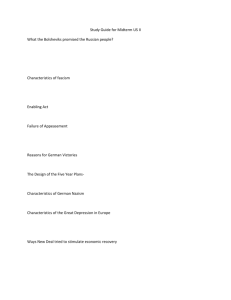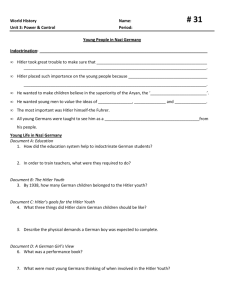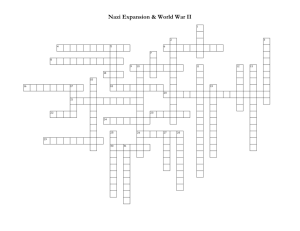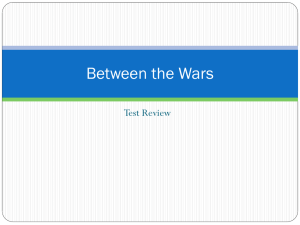File
advertisement
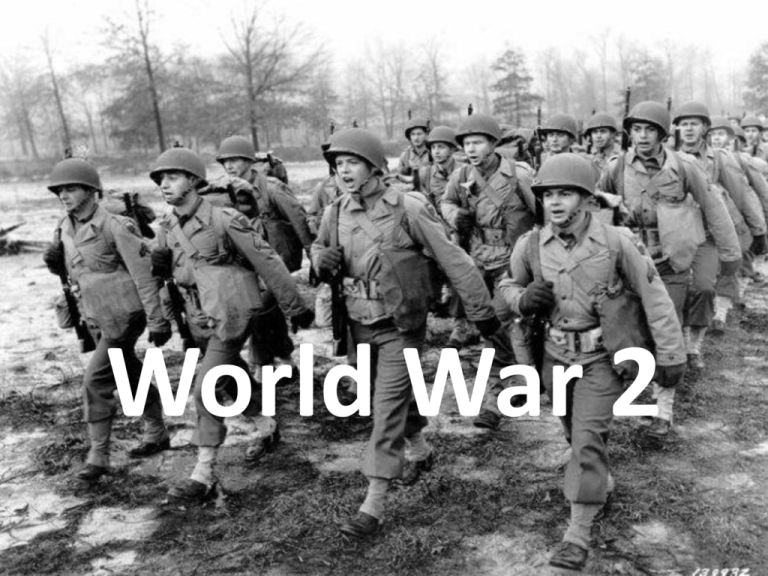
World War 2 • After being blamed for World War 1 (19141918) Germany was forced to pay huge compensation costs. It also had to give up some of its land and was only allowed to have a small army. Due to this, the country was in a state of depression. This meant that people were very poor and jobs were very scarce. Many people were unemployed and struggled to make ends meat. Austria, a neighbouring country, was also in a similar state. • Adolf Hitler was living in Austria at this time. He was a “down and out” and struggled to make money as an artist. • While living here he became extremely jealous of the Jewish people who were prosperous and had much more money than he had. • This is when Adolf began to hate the Jewish people and started plotting against them. • Hitler decided to join the German Army as he felt a sense of duty to serve in the army and had failed to get into the Austrian army. • In the early 1920s, Hitler formed a small, badly organised group in which they tried to take over Germany. This was known as a ‘coup’. This is because they wanted to make Germany the most powerful country in Europe. • Their plans failed though, and Hitler ended up in jail. Hitler stages a coup in Munich (1923) • While he was in jail Hitler wrote a book called “Mein Kampf” which means ‘my struggle’. • In this book he wrote about his beliefs. He wrote about his hatred of the Jews called antiSemitism . • He also believed that he could bring Germany to power and conquer other countries in Europe. • He wanted to take over other countries and give Germans more land to live on. • First of all though he needed to gain power. • Hitler set up the Nazi (meaning Nationalist Socialist) party in Germany who all shared his beliefs. • In 1933, he won the general election and became the Chancellor of Germany. • He called himself the Fuhrer (leader) and he was determined to lead as a dictator- this meant taking total control of the state. The Nazi logo was called the swastika Hitler is appointed Chancellor Why did the people vote Hitler as the Chancellor? • The people voted Hitler in as chancellor because he made many great promises. • These promises were to create more jobs, to improve the roads and to make Germany a more powerful country. • He did keep these promises and for a while was very popular amongst the German people. Hitler making a speech Hitler Begins to Take Over • In 1938 Germany invaded Austria. He wanted to increase German territories. Some of the Austrian people were happy though because they believed Hitler could make their country wealthy and successful. • He also took over Czechoslovakia in 1939. • The other countries in Europe were becoming worried that Hitler would try take over their country next. They knew Poland was next on Hitler’s list. • The French and British leaders announced that if Hitler invaded Poland they would go to war with Germany. They hoped this would scare Hitler. World War Two Begins! • On the 1st of September 1939, German forces stormed into Poland. • As soon as Britain and France heard this, they sent Hitler an ultimatum. Withdraw or war would be declared. • Hitler ignored this warning and war was declared on 3rd September 1939. • World War II had begun! • http://www.bbc.co.uk/schoolradio/history/worldwar2a udioclipslibrary_clip01.shtml World War 2 Lesson 2 • Eight other countries including Italy and Japan decided to side with Germany. These countries became known as the Axis Powers. • Fifty countries fought against Germany, including Britain, France, Russia, Canada, Australia and the USA. Some of these countries joined the war later on while others such as Britain and France were involved from the very start. These countries were known as the Allies. Axis Powers V Allies Axis Powers Germany Italy Japan Allies Britain France Russia Canada Australia United States of America Invading Poland: • The Germans introduced a new system of warfare known as Blitzkrieg-which meant ‘lightning war’ • This involved heavy bombings from the sky, leaving the people below trapped, followed by the invasion with troops in tanks, lorries and even some soldiers were parachuted in. • Britain and France wanted to help Poland but were not prepared in such a short time. • By April 1940, Hitler had taken over Holland, Belgium, Denmark and Norway. • In May 1940 German troops invaded France, who were unable to resist the German forces, leaving Britain alone to fight against Germany. • At this time the British Army was unprepared compared to the German Army which had been in full force for over a year. The Battle of Britain • German leaders felt it was essential to destroy the British air force to stop it sinking ships that would carry German soldiers across the channel. • The Battle of Britain took place in the skies between British and German planes and was Germany’s attempt to destroy the British air force. • The German Air Force, known as the Luftwaffe, made their first attack on British ships in July 1940 German fighter plane British fighter plane • The British fought back with their Royal Air Force (RAF) • Between July and October 1940 bombings took place almost every night. The Blitz • Hitler failed to destroy the British air force. He then looked to bomb British cities instead. • From September 1940, Germany repeatedly bombed British cities. This was known as the Blitz • London, Coventry, Glasgow and Liverpool were repeatedly hit. • During the Blitz more than two million homes were destroyed and 60,000 people were killed. London during the Blitz (1941) • The RAF had one secret weapon that the Germans didn’t-radar. • Using this device the RAF could warn the people down below to get shelter as they could track on coming German planes. • The Germans lost the element of surprise! Neutrality: • During this time, some countries remained neutral. This meant that they refused to take part in the war. • These countries were: *Ireland *Switzerland *Spain *Sweden *Portugal Pearl Harbour • During the Battle of Britain, German forces dropped almost 175,000 tonnes of bombs. • When Japan attacked the US naval base at Pearl Harbour in Hawaii in 1941, America decided to join the Allies and fight against the Axis Powers. • Up to this point many Americans did not wish to enter the war. • However, after the destruction of Pearl Harbour, the people’s opinions changed and the American people did not want the Axis Powers to conquer any more countries. • The American president Franklin D Roosevelt declared war on the Axis Powers 4 days after the bombing of Pearl Harbour. • This was a great boost to the Allies. • Between 1942 and 1944, the Allies made thousands of raids over Germany, aiming their bombs specifically at German weapon factories. They also targeted dams which were used to generate electricity. Railways, roads and bridges were also destroyed to prevent Germany form moving their troops and supplies. 600,00 German civilians died in these attacks and the German roads and railways systems were practically destroyed. • The Allies then planned a massive attack on the German troops who were stationed at Normandy in France. This attack was planned for 6th June 1944 which became known as DDay. • The Germans resisted this attack well but the Allies reached Paris in August 1944 and were waiting for orders to invade Germany. • By April 1945 the Allies were marching towards Germany from all sides. War in Europe is Over • At this point, Hitler realised he had been defeated. He killed himself on 30th April 1945. • On the 8th May 1945, the Germans surrendered, ending war in Europe. • This day became known as VE Day (Victory in Europe Day) The Atomic Bombs • The Allies then called on the Japanese to surrender, which they refused to do. • In the meantime, the Americans had developed a new lethal bomb known as the atomic bomb. • They decided to drop two of these bombs on Japan in the hope that this would force Japan to surrender. The bombing of Hiroshima • The first bomb was dropped on Hiroshima. Nearly 100,000 people were killed in this blast. • Thousands more died in the following months and years from their injuries as well as radiation. • Three days later, a second atomic bomb was dropped on Nagasaki. • http://www.youtube.com/watch?v=ncq_Wye 43TM&feature=fvwrel • Over 40,000 Japanese died in this blast. • The Japanese realised they could not survive another one of these bombs like this. • They surrendered on 2nd September 1945 • World War 2 was finally over. Aftermath of World War 2 • It is estimated that about 72 million people died during World War 2 • 61 million were on the allied side and 11 million were on the axis side • Of the 72 million people that died, it is believed that 6 million of these were Jewish people.

